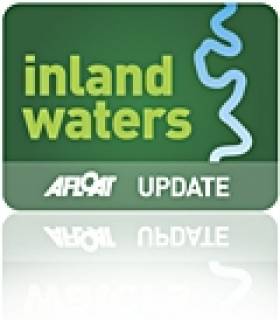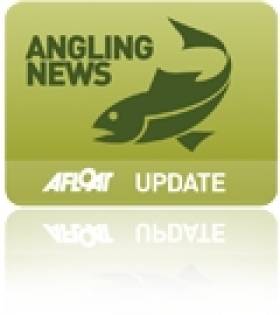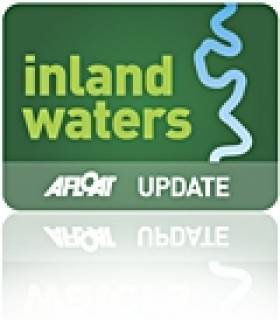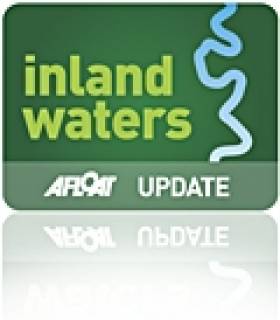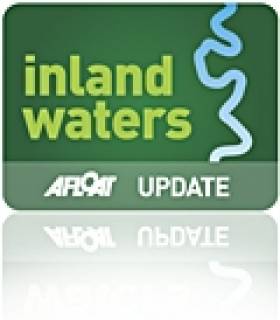Displaying items by tag: inland waterways
#InlandWaters - Waterways Ireland has confirmed that the construction project to develop houseboat mooring facilities for the Grand Canal in Sallins, Co Kildare has now recommenced on site.
It's now advised that as a consequence of the delay, which Waterways Ireland assures was unforeseen, the contract will now be completed in August.
Waterways Ireland says it "will ensure that the previous contractual difficulties do not result in any reduction in the quality or standard of the completed project.
"Waterways Ireland apologies to customers, residents and local businesses for any inconvenience caused by the unforeseen delay to the contract."
For further information please see Waterways Ireland's current Waterway Work Programmes.
Enquiries relating to the Sallins Houseboat Facility project are directed Waterways Ireland's on-site representative at 087 990 1935.
#InlandWaters - Waterways Ireland's recent report on consultation responses to the proposed changed to canal bye-laws is "an incomplete document" according to the Inland Waterways Association of Ireland (IWAI).
In a statement, the IWAI listed its criticisms of the report, namely that:
- There is no mention of the meeting with the Oireachtas Joint Committee on Environment, Culture and the Gaeltacht;
- There is no commentary on requests to change the future consultation period from 21 days to three months so that it is compatible with the Corporate Plan Consultation period and more customer friendly;
- There is no commentary on winter mooring provision on the Royal and Grand Canals and River Barrow as is provided on the Shannon navigation;
- Service level agreements and a customer services charter are not included;
- There is no mention of houseboats, despite this being a major issue;
- It fails to note that only one user group is still being subjected to charges;
- There is no mention of the €250 deposit on the extended mooring permit;
- There is no mention of the Barrow open boat fishing licence;
- There is no mention of requests to have a multi-agency approach to planning;
- There is no mention of daily mooring charges in Grand Canal Docks;
- There are no details provided on any impact assessment reports conducted by Waterways Ireland on proposals;
- The Dutch Barge Association submission is not noted or copy posted with all other submissions on the website; and
- The report includes what IWAI considers to be a wholly inaccurate statement on negative effect on tourism.
The association also claims that the report is "contradictory in itself", noting that "the section dealing with Waterways Ireland responses to the various submissions indicates that prior to addressing all concerns in relation to the bye-laws, there is significant work to be done by Waterways Ireland on a number of issues.
"Yet the section on the consultation process states that they have completed a final report with changes arising from consideration of the consultation process, and once viewed by senior counsel it will be forwarded to the Minister for Arts, Heritage and the Gaeltacht for his consideration and final decision."
The IWAI reiterated its position that the proposed Waterway Ireland canal bye-laws "do not put user requirements, tourism development and local communities at the centre of the regulations."
Father & Son Convicted For Illegal Fishing In Ennistymon
#Angling - At recent sitting of Ennis District Court, father and son Peter and James Garrihy of Ennistymon, Co Clare were successfully prosecuted and fined €750 each by Inland Fisheries Ireland (IFI) for illegally capturing salmon on the River Inagh, near the iconic falls at Ennistymon.
In August 2013, IFI fisheries officers were carrying out night surveillance on the Inagh River when they observed the two men using a net and illegally capturing salmon.
Both pleaded guilty to the charge of possession of illegally captured salmon.
In making his judgement, Judge William Early queried the weight of the fish caught and the possible damage that was caused to the river by the removal of salmon that would have been capable of spawning that winter.
He added that it was unfortunate that the conservation measures which have been put in place to restore the river are being disregarded.
The Inagh River is currently closed to salmon angling as it is failing to meet its conservation limit. This means that there are not enough salmon returning to spawn to sustain salmon numbers required for the river.
IFI is in the process of installing a fish counter on this river to further assist in determining the return of salmon to the river.
The fisheries body's Limerick director Amanda Mooney said: “This blatant predation of salmon is unacceptable and these fish are the future to the survival of the species within these river catchments.
"Incidents of this nature are can be detrimental to the wild salmon stocks as they are under severe threat nationally and internationally with numbers declining annually.
"I would urge people not to purchase any illegally caught fish and to report any suspected illegal activity to Inland Fisheries Ireland.”
Illegal salmon fishing is an environmental crime, and IFI says it will continue its efforts to protect and conserve this valuable natural resources. Members of the public can report any illegal fishing activity on a 24-hour confidential hotline at 1890 FISH 24 (1890 347424).
#ShannonErne - Waterways Ireland welcomed Canadian Ambassador Loyola Hearn and his wife Maureen to celebrate the 20th anniversary of the opening of the Shannon-Erne Waterway earlier this month.
The ambassador arrived in Leitrim village on a Waterways Ireland boat, and after meeting with representatives from Inland Fisheries Ireland and the Inland Waterways Association of Ireland at the local marina, he planted a maple tree as a symbol of strength and endurance in Canada.
Waterways Ireland chief executive Dawn Livingstone led the ambassador on a visit to Glenview Folk Museum alongside Lock 5 of the waterway, after which he visited Riversdale Barges, where he took in a barge building project with owner Graham Thomas.
On a traditional barge, the ambassador and his party travelled on to Ballinamore where they were met at the community marina by Sadie McGovern of Ballinamore Development Association, Locaboat hire boat company manager Phillipe Ducont and children from three local schools.
Ambassador Hearn was joined by Livingstone in presenting certificates to St Brigids National School in Drumcong and Scoil Brid and St Patrick's National Schools in Ballinamore for their work on the Waterways Ireland Education Programme.
Canada was a major contributor to the International Fund for Ireland that covered the costs of the Shannon-Erne Waterway, which opened in 1994 as the first corss-border waterway project in Ireland.
In related news, Waterways Ireland is now selling a Navigational Guide to the Shannon and Erne Waterways, a comprehensive A3 booklet with section-by-section guides complete with drawings, photos, instructions and navigation tips.
The new guide is available from the Waterways Ireland online shop for €15.
#WaterSafety - The crew of Bundoran RNLI's lifeboat, together with local fishermen and members of Irish Water Safety, recently welcomed a group of students from Lucan, Co Dublin who created a new school’s guide to water safety in Ireland’s rivers, lakes and seas.
The group of students from St Joseph’s College in Lucan are participating in the 2014 Young Social Innovators programme and were tasked with picking an issue of concern in their local area and to take action to change it for the better.
They decided to tackle the ongoing problem of drowning, particularly after the tragic summer last year when so many young people lost their lives needlessly during the hot spell.
Their vision for the information pack is to “think before you splash” – encouraging young people to become more involved in water activities and to increase their awareness of the water.
The pack consists of a lesson plan for teachers as well as a local ecology & water safety survey, 10 water safety rules and more.
Speaking during the visit, Bundoran RNLI crewmember Killian O’Kelly said: "It’s heartening for us who volunteer to save lives at sea to see this initiative being undertaken so enthusiastically by this group of students – they are to be commended for such an excellent piece of work and if it helps to save one life this summer then it’s time well spent."
The group hope to make the booklet available online in the coming weeks.
Name That Stream! Blackrock School Pupils Need Your Help
#InlandWaterways - Can you help pupils at Blackrock's International School Dublin identify the stream behind their building?
The 9-to-12-year-olds in Miss Nelson's class have been researching the natural history of the neighbourhood surrounding their school in South Co Dublin, but have been stumped by the stream that runs behind the school building.
The narrow waterway runs north through St Louise's Park and alongside Barclay Court before going under and through Blackrock. Visible on many online maps, it's only labelled by name on one as the Carysfort-Maretimo Stream.
Miss Nelson's class are hoping any locals reading this can confirm if their stream is indeed known by that name, and any other information about it such as its history, where it rises and where it flows.
If you think you can help, please leave a comment below!
#Fracking - Fracking in Northern Ireland could pose a serious risk to endangered fish species, as a cross-border group of anglers highlighted last weekend.
The Irish Times reports on the protest rally in Enniskillen on Saturday 1 March that has called for a referendum on fracking in the North to coincide with this May's local elections.
Their concerns come on the heels of January's poor assessment of Stormont's regulatory powers over shale gas extraction beneath some of the North's inland waterways by environmental group Friends of the Earth.
“We have the highest degree of protection from the EU, but it would only take one accident to destroy the lake if they start to drill,” said rally organiser Malcolm Finney of Lough Melvin, home to rare species such as sonaghan trout and Arctic char.
Beyond the island of Ireland, meanwhile, fears of an 'ocean catastrophe' are growing as mining interests turn their attentions to the unexplored depths of the world's seas previously thought inaccessible.
As The Guardian reports, marine scientists are alarmed at "the prospect of a race to the bottom of the ocean – a 21st-century high seas version of the Klondike gold rush."
As prices for metals extracted by traditional mining methods rise, the temptation to harvest ore deposits from sea floor sediment only grows - but at what price to the world's marine ecosystem? The Guardian has more on the story HERE.
IWAI Issue Giant Valentine Card to Show Love for Inland Waterways
#inland – The Inland Waterways Association have issued an early Valentine verse to senior politicians:
We love the waterways, and boats!
You love the communities, and votes?
Given the season, let's make a date...
XXX – one kiss each from the Royal Canal, the Grand Canal, and the River Barrow
At the Executive Council meeting of the Inland Waterways Association of Ireland (IWAI) on 10th February, Carmel Meegan, President of IWAI re-iterated - "the proposed bye-laws do not put user requirements, tourism development and local communities at the centre of the regulations."
By the end of the Waterways Ireland public short consultation period of 21 days (to 3 pm on Feb 3rd last), waterways locations affected had sent over 1800 letters of concern to IWAI (for IWAI to submit to Waterways Ireland), with notice to the IWAI of several hundred further submissions to WI. These 2,000 submissions; Parliamentary Questions; and enquiries from Councillors, are evidence of concern. This is a mandate for the IWAI to move into the next stage of a campaign. Other waterways organisations now permit the IWAI publish their submissions at www.iwai.ie
The consultation period included questions from members of the Seanad and the Dail; national and local press articles; radio interviews; community websites; blogs and Facebook pages; and increasing interest in the Grand and Royal Canals and River Barrow as a national resource.
The IWAI are distributing a giant Valentine Card to show our regard for the inland waterways that will be affected, and for the communities that have supported the bye-laws campaign to date.
Politically, this is a very big issue.
IWAI has advised that Mr. Jimmy Deenihan, TD, Minister for Arts, Culture and the Gaeltacht, will sign proposed new rules into law, if these new regulations are finalised.
The bye-laws should concern Mr. Leo Varadkar, TD, Minister for Tourism, Transport and Sport on the potential of the 'Green and Silver' navigation route, from Dublin to the Shannon via the Grand or Royal Canals and vice versa, promoted by Dublin IWAI - now under threat.
Further, the work of Mr. Phil Hogan, TD, Minister for Environment, Community and Local Government should not be ruined by Waterways Ireland doing their own thing with a national resource. The Local Government Reform Bill 2014 gives localities more power. The rushed bye-law consultation process mitigates against resource co-ordination and alignment.
The IWAI now suggests that opportunities for enterprise development on inland navigations should also interest Richard Bruton, TD, Minister for Jobs, Enterprise and Innovation.
The boating community is not averse to appropriate management, facility provision, and access to waterways. But boats are key attractions, as the lifeblood of the navigations, and need to be welcomed.
Who to contact for further information
Gregory Whelan, IWAI, p: +353-87-7996356 e: [email protected]
Alan Kelly, IWAI, Mobile: +353-86-8326275
John Dolan, IWAI, Mobile: +353-87-9021039
Notes to Editor Notes to Editor Notes to Editor Notes to Editor Notes to Editor Notes to Editor Notes to Editor Notes to Editor Notes to Editor Notes to Editor – the IWAIthe IWAIthe IWAIthe IWAIthe IWAIthe IWAIthe IWAI
The Inland Waterways Association of Ireland (IWAI) is a voluntary body representing over two thousand enthusiasts, with 22 branches across the island of Ireland.
The Inland Waterways Association of Ireland (IWAI) is an energetic, fun, voluntary organisation with members from all corners of the Island of Ireland, all sharing a keen and passionate enthusiasm for the waterways of Ireland.
The IWAI advocates the navigation, use, maintenance, protection, restoration and improvement of the inland waterways of Ireland. It was formed in 1954 to promote the development, use and maintenance of Ireland's navigable rivers and canals.
When the Shannon was almost totally undeveloped for pleasure boating, the IWAI campaigned against the building of low bridges, thus ensuring the development of the river as a national asset. In the 1960s IWAI successfully fought plans to close the Circular Line of the Grand Canal in Dublin. Later the Association campaigned for the re-opening of what is now the Shannon - Erne Waterway (formerly the Ballinamore & Ballyconnell Canal) and the Naas Line of the Grand Canal.
IWAI played its part in the restoration campaign for the re-opening of the Royal Canal between Dublin and the Shannon in recent years. IWAI assistance to the campaign to re-open the Ulster Canal has also borne fruit with the announcement that work is to begin on re-opening the section from the Erne to Clones. Currently, IWAI members are active in restoration projects on the Boyne, Newry and Lagan Canals.
IWAI Branches hold approximately 200 events each year across inland navigations with the wider communities in many locations. These events include Boat Rallies, Harbour Festivals, Walks, Social Gatherings, Heritage Activities; Family activities and Youth focused events.
Ireland's Canal Users Mobilise Against New Bye-Laws, Charges
#Canals - Mooring permits costing up to €3,500 are among "a raft of charges and tolls" on the way for users of Ireland's inland waterways, according to the Irish Independent.
Last week the Inland Waterway's Association of Ireland lambasted new bye-law proposals that it fears will kill off "200 years of activity" on this country's canals.
And now the Irish Independent's John Drennan outlines some of these new charges, which include fees for boats "not constantly cruising or navigating" that start at €160 and rise to some €3,500 a year for large houseboat mooring permits.
Other fees include a €25 toll for passage through a series of locks in the capital, and a 'five-day rule' that will fine canal users €150 for keeping their vessels in one location for more than that time.
And the plans - currently open for consultation which ends next Monday 3 February - are prompting protest among waterways enthusiasts, with meetings planned next week in Sallins and Dublin amid fears that the canals will be abandoned by waterways users.
The Irish Independent has more on the story HERE.
NatGeo Readers' Most Impressive Photos Of Ireland
#Photos - National Geographic has compiled a gallery of some of its readers impressive photographs of Ireland's world-renowned scenery, with coastal and inland waterfront shots making up the bulk of the collection.
From the rough and tumble of surf-lashed Kinard to the tranquil still waters of Killarney National Park, the welcoming wildlife of Donegal Bay and so much more between, the wealth of vistas on our little island is truly astounding.


























